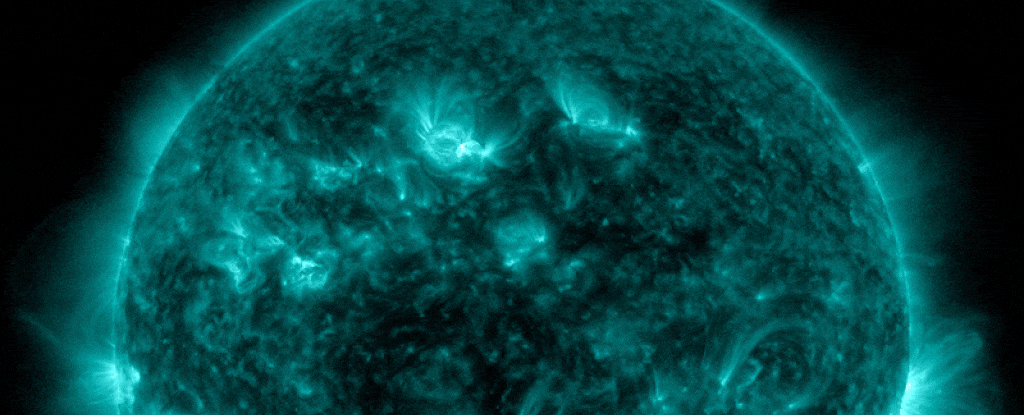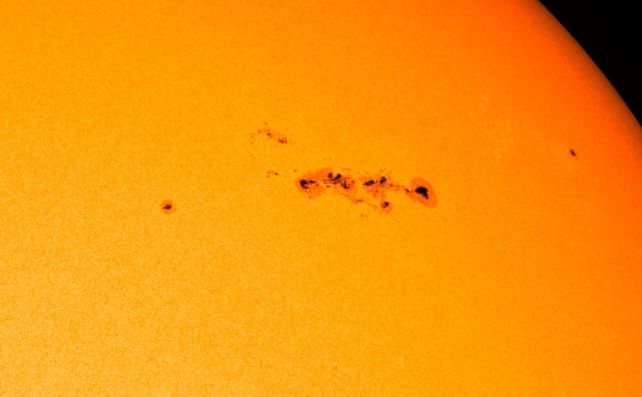ARTICLE AD
 The X1.6 flare that took place on 3 May, just days before two more flares erupted. (NASA SDO)
The X1.6 flare that took place on 3 May, just days before two more flares erupted. (NASA SDO)
Some of the most powerful flares our Sun can muster have just erupted, each directed in such a way to have a noticeable effect here on Earth.
On 5 May 2024, an X1.3 flare and an X1.2 flare erupted from active sunspot cluster AR 3663, at 0601 and 1154 UTC, respectively, according to the NOAA's Space Weather Prediction Center.
Each flare produced a radio blackout here on Earth, and we may see ongoing effects, if there were accompanying coronal mass ejections (CMEs) that hurled charged particles in our direction.
That's not a certainty; the UK Met Office notes that no obvious Earth-directed CMEs were observed. However, as the coronagraph technology used to see CMEs is currently either unavailable or limited, there may very well have been a CME that we didn't catch sight of.
At time of writing, there are nine sunspot clusters, or regions, on the side of the Sun facing Earth, with more than 150 sunspots between them. AR 3663, however, appears to be the most active. It appeared on 30 April and has to date emitted 14 M-class flares and 3 X-class flares – the second most and most powerful flares the Sun can produce.
Scientists predict that more M-class flares will emerge from the region, and maybe another X-class or two, before it rotates to the far side of the Sun, away from Earth.
 Active region 3663. (NASA SDO)
Active region 3663. (NASA SDO)Solar flares are spectacular eruptions of plasma on the surface of the Sun, powered by the snapping and reconnecting of magnetic field lines over sunspots – regions where the solar magnetic field is temporarily stronger. The flashes of X-ray and ultraviolet light associated with these explosions can lash Earth's ionosphere on the sunlit side, causing temporary radio blackouts.
Sometimes, a solar flare is accompanied by a CME. This is a huge release of plasma and magnetic field from the Sun, spewed out into space. These eruptions sometimes hit Earth, although they take a bit longer to get here, since plasma travels somewhat slower than light.
When they do arrive, however, the effects – known as a geomagnetic storm – are significantly more profound.
When the CME reaches Earth, it smacks into the planet's magnetosphere; this produces electrical currents that can flow through the power grids, causing fluctuations and blackouts. Currents generated in low-Earth orbit can affect satellites, requiring course corrections, and radio and navigation signals can be affected.
The best part, though, is the aurora. The interaction between solar particles, Earth's magnetosphere, and Earth's atmosphere creates an ethereal glow in the night sky around the poles (during the day, too; you just can't see it because sunlight is too bright).
Currently, there are no geomagnetic storms predicted for the two flares of 5 May, but there are geomagnetic storms just about to hit Earth from a previous solar flare.
On May 3, AR 3663 spat out an X1.6 flare, and a CME is expected to generate a moderate geomagnetic storm on May 6, including power grid fluctuations, satellite drag, and fading radio signals at high latitudes.
Aurora, the NOAA also notes, "may be seen as low as New York to Wisconsin to Washington state."
Because AR 3663 is now rotating away from Earth, any more eruptions in the days to come are likely to have a much smaller effect, even for X-class flares. But not to worry – we're currently right in the swing of the peak of the Sun's 11-year activity cycle. No doubt more solar shenanigans loom for the months ahead.

 8 months ago
59
8 months ago
59 

